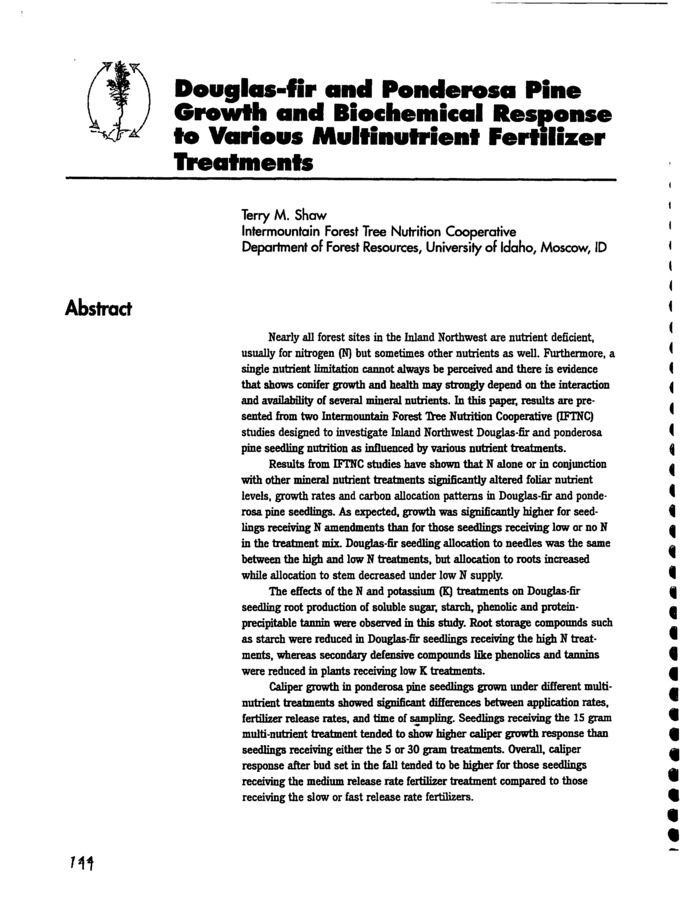PDF
Douglas-fir and Ponderosa Pine Growth and Biochemical Response to Various Multinutrient Fertilizer Treatments Item Info
- Title:
- Douglas-fir and Ponderosa Pine Growth and Biochemical Response to Various Multinutrient Fertilizer Treatments
- Creator:
- Shaw, T.M.
- Date Created (ISO Standard):
- 1997
- Approximated Date:
- yes
- Description:
- Nearly all forest sites in the Inland Northwest are nutrient deficient, usually for nitrogen (N) but sometimes other nutrients as well. Furthermore, a single nutrient limitation cannot always be perceived and there is evidence that shows conifer growth and health may strongly depend on the interaction and availability of several mineral nutrients. In this paper, results are presented from two Intermountain Forest Tree Nutrition Cooperative (IFTNC) studies designed to investigate Inland Northwest Douglas-fir and ponderosa pine seedling nutrition as inftuenced by various nutrient treatments. Results from IFTNC studies have shown that N alone or in conjunction with other mineral nutrient treatments significantly altered foliar nutrient levels, growth rates and carbon allocation patterns in Douglas-fir and ponderosa pine seedlings. As expected, growth was significantly higher for seedlings receiving N amendments than for those seedlings receiving low or no N in the treatment mix. Douglas-fir seedling allocation to needles was the same between the high and low N treatments, but allocation to roots increased while allocation to stem decreased under low N supply. The effects of the N and potassium (K) treatments on Douglas-fir seedling root production of soluble sugar, starch, phenolic and protein-precipitable tannin were observed in this study. Root storage compounds such as starch were reduced in Douglas-fir seedlings receiving the high N treatments, whereas secondaiy defensive compounds like phenolics and tannins were reduced in plants receiving low K treatments. Caliper growth in ponderosa pine seedlings grown under different multi-nutrient treatments showed significant differences between application rates, fertilizer release rates, and time of sampling. Seedlings receiving the 15 gram multi-nutrient treatment tended to show higher caliper growth response than seedlings receiving either the 5 or 30 gram treatments. Overall, caliper response after bud set in the fall tended to be higher for those seedlings receiving the medium release rate fertilizer treatment compared to those receiving the slow or fast release rate fertilizers.
- Subjects:
- research (document genres) fertilizer timber (lumber) statistics
- Location:
- North and Central Idaho; Eastern Washington; Western Montana; Northeastern Oregon
- Publisher:
- Department of Forest Science, Oregon State University, Corvallis
- Source:
- Shaw, T.M., 1997. Douglas-fir and ponderosa pine growth and biochemical response to various multinutrient fertilizer treatments. P 144-153. In Haase, D.L. and Rose, R. (Eds.) Symposium proceedings: forest seedling nutrition from the nursery to the field, Corvallis, Oregon, Oct. 28-29, 1997. Nursery Technology Cooperative, Department of Forest Science, Oregon State University, Corvallis.
- Source Identifier:
- DF_+_PP_Growth_and_Biochemical_Response_to_Var_Multinutrient_Fertilizer_Treatments_Symposium_Proceedings_1997
- Type:
- Text
- Format:
- application/pdf
- Language:
- eng
Source
- Preferred Citation:
- "Douglas-fir and Ponderosa Pine Growth and Biochemical Response to Various Multinutrient Fertilizer Treatments", Idaho Forestry Research Collection, University of Idaho Library Digital Collections, https://www.lib.uidaho.edu/digital/forestryresearch/items/forestryresearch899.html
Rights
- Rights:
- In copyright, educational use permitted. Educational use includes non-commercial reproduction of text and images in materials for teaching and research purposes. For other contexts beyond fair use, including digital reproduction, please contact the University of Idaho Library Special Collections and Archives Department at libspec@uidaho.edu. The University of Idaho Library is not liable for any violations of the law by users.
- Standardized Rights:
- http://rightsstatements.org/vocab/InC-EDU/1.0/

